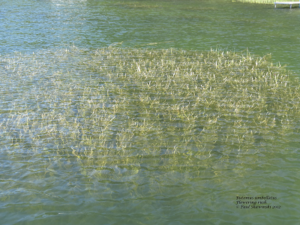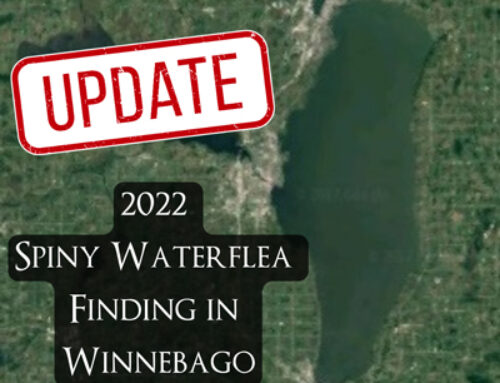Every month, we will put a spotlight on an aquatic invasive species (AIS) in a re-occurring monthly article. Check it out! This month, we highlight an ornamental plant that is appearing in more waterways – Flowering Rush!
Flowering Rush
Flowering rush (Butomus umbellatus) is a wetland plant that was first documented in North America in the St. Lawrence River in 1897. Flowering rush (FR) is native to Europe and Asia. Similar to purple loosestrife, FR was imported to North America for water garden usage and made its way into waterways by people releasing it. However, seeds from FR were also brought to North America unintentionally in soil used as solid cargo ship ballast (the precursor to ballast water that is used today).
One of the most distinct features of FR is that it produces an umbrella-shaped structure of flowers on a flower stalk. Each flower has three pink petals and flowers bloom in June through August. While the plant does produce seeds, these seeds are often not viable. The low seed viability may help explain why it was not discovered in Wisconsin until 1958 even though it was in North America in 1897. FR tends to spread through its bulbil structures. These bulbils are parts of the plants rhizome, the underground stem of the plant from which roots and shoots grow. Bulbils are detached and can be carried by water to new areas where they can germinate and grow. Pieces of the rhizome can also break off and form new plants.
However, when FR is not flowering, there are still a few ways to help identify the plant. The leaves are tall and extend directly from the roots compared to from a stem. In addition, the leaves often twist and spiral as they grow especially at the tip of the leaf. Another distinguishable feature is the triangle shape of the leaves. Instead of a flat leaf, the leaves of FR are distinctly triangular that is most easily seen when looking at the leaf’s cross-section.
 FR has two forms in which it can grow; submergent and emergent. FR typically grows in a few feet of slow moving water where it emerges out of the water when growing. However, given the right conditions, FR can grow as deep as 6 feet and live submerged in the water. In its submerged form, the plant will not produce flowers and will only reproduce by releasing bulbils.
FR has two forms in which it can grow; submergent and emergent. FR typically grows in a few feet of slow moving water where it emerges out of the water when growing. However, given the right conditions, FR can grow as deep as 6 feet and live submerged in the water. In its submerged form, the plant will not produce flowers and will only reproduce by releasing bulbils.
Since FR can create numerous plants from the same rhizome and spread through bulbils, it can quickly start to dominate an invaded wetland. It displaces native vegetation along the shoreline of the invaded waterbody and can get in the way of recreation activities such as boating, hunting, and fishing. Due to the small size of the bulbils, it can easily hitchhike on recreational gear and be transported between waterbodies.
Flowering rush is classified as a Restricted species in all counties across Wisconsin.
Want to help? HELP PREVENT THE SPREAD!
Every time you come off the water, make sure to follow these steps to stop the spread of faucet snails and other aquatic invasive species:
* Inspect boats, trailers, push poles, anchors, and other equipment for attached aquatic plants or animals. 
* Remove all attached plants or animals
* Drain all water from boats, motors, livewells and other equipment
* Never move live fish away from a waterbody
* Never release aquarium plants or animals into your local waterways
Follow the Fox Wolf Watershed Alliance’s Winnebago Waterways Program on our Winnebago Waterways Facebook page or @WinnWaterways on Twitter! You can also sign-up for email updates at WinnebagoWaterways.org.
Questions? Comments? Contact Chris Acy, the AIS Coordinator for the Winnebago Waterways Program covering Fond du Lac, Calumet, and Winnebago Counties at (920) 460-3674 or chris@fwwa.org!
Winnebago Waterways is a Fox-Wolf Watershed Alliance program. The Fox-Wolf Watershed Alliance is an independent nonprofit organization that identifies and advocates effective policies and actions that protect, restore, and sustain water resources in the Fox-Wolf River Basin.
Photo Credit: Paul Skawinski, Chris Acy





